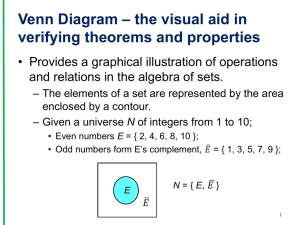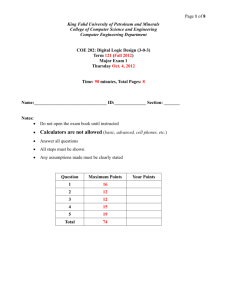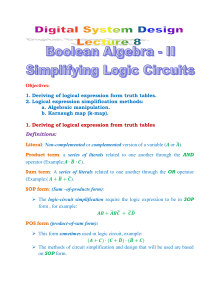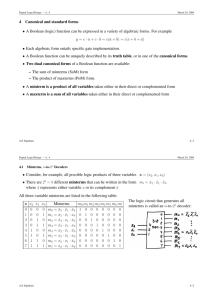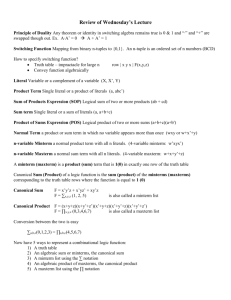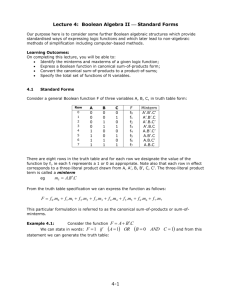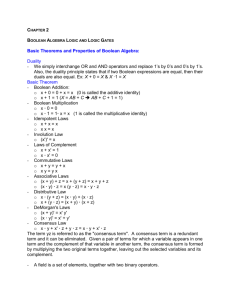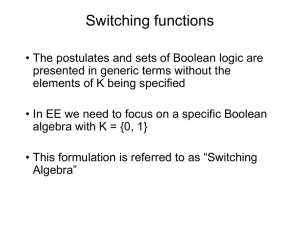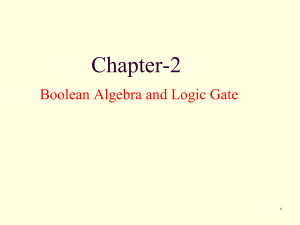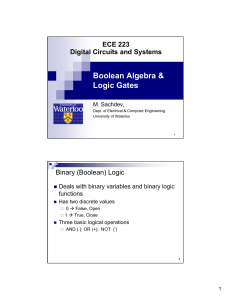3.5 Canonical Forms
advertisement
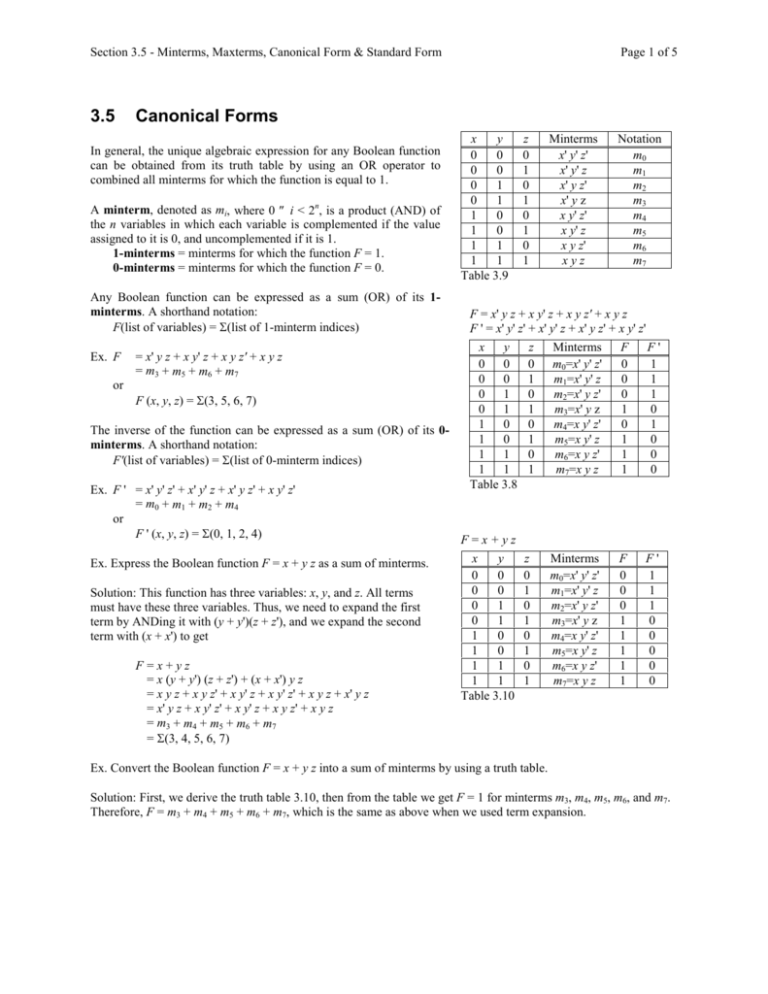
Section 3.5 - Minterms, Maxterms, Canonical Form & Standard Form 3.5 Canonical Forms In general, the unique algebraic expression for any Boolean function can be obtained from its truth table by using an OR operator to combined all minterms for which the function is equal to 1. A minterm, denoted as mi, where 0 ≤ i < 2n, is a product (AND) of the n variables in which each variable is complemented if the value assigned to it is 0, and uncomplemented if it is 1. 1-minterms = minterms for which the function F = 1. 0-minterms = minterms for which the function F = 0. Any Boolean function can be expressed as a sum (OR) of its 1minterms. A shorthand notation: F(list of variables) = Σ(list of 1-minterm indices) Ex. F Page 1 of 5 = x' y z + x y' z + x y z' + x y z = m3 + m5 + m6 + m7 or F (x, y, z) = Σ(3, 5, 6, 7) The inverse of the function can be expressed as a sum (OR) of its 0minterms. A shorthand notation: F'(list of variables) = Σ(list of 0-minterm indices) Ex. F ' = x' y' z' + x' y' z + x' y z' + x y' z' = m0 + m1 + m2 + m4 or F ' (x, y, z) = Σ(0, 1, 2, 4) Ex. Express the Boolean function F = x + y z as a sum of minterms. Solution: This function has three variables: x, y, and z. All terms must have these three variables. Thus, we need to expand the first term by ANDing it with (y + y')(z + z'), and we expand the second term with (x + x') to get F=x+yz = x (y + y') (z + z') + (x + x') y z = x y z + x y z' + x y' z + x y' z' + x y z + x' y z = x' y z + x y' z' + x y' z + x y z' + x y z = m3 + m4 + m5 + m6 + m7 = Σ(3, 4, 5, 6, 7) x y 0 0 0 0 0 1 0 1 1 0 1 0 1 1 1 1 Table 3.9 z 0 1 0 1 0 1 0 1 Minterms x' y' z' x' y' z x' y z' x' y z x y' z' x y' z x y z' xyz Notation m0 m1 m2 m3 m4 m5 m6 m7 F = x' y z + x y' z + x y z' + x y z F ' = x' y' z' + x' y' z + x' y z' + x y' z' x y 0 0 0 0 0 1 0 1 1 0 1 0 1 1 1 1 Table 3.8 z 0 1 0 1 0 1 0 1 Minterms m0=x' y' z' m1=x' y' z m2=x' y z' m3=x' y z m4=x y' z' m5=x y' z m6=x y z' m7=x y z F 0 0 0 1 0 1 1 1 F' 1 1 1 0 1 0 0 0 Minterms m0=x' y' z' m1=x' y' z m2=x' y z' m3=x' y z m4=x y' z' m5=x y' z m6=x y z' m7=x y z F 0 0 0 1 1 1 1 1 F' 1 1 1 0 0 0 0 0 F=x+yz x y 0 0 0 0 0 1 0 1 1 0 1 0 1 1 1 1 Table 3.10 z 0 1 0 1 0 1 0 1 Ex. Convert the Boolean function F = x + y z into a sum of minterms by using a truth table. Solution: First, we derive the truth table 3.10, then from the table we get F = 1 for minterms m3, m4, m5, m6, and m7. Therefore, F = m3 + m4 + m5 + m6 + m7, which is the same as above when we used term expansion. Section 3.5 - Minterms, Maxterms, Canonical Form & Standard Form A maxterm, denoted as Mi, where 0 ≤ i < 2n, is a sum (OR) of the n variables (literals) in which each variable is complemented if the value assigned to it is 1, and uncomplemented if it is 0. 1-maxterms = maxterms for which the function F = 1. 0-maxterms = maxterms for which the function F = 0. Any Boolean function can be expressed as a product (AND) of its 0maxterms. A shorthand notation: F(list of variables) = Π(list of 0-maxterm indices) Ex. F = (x+y+z) • (x+y+z') • (x+y'+z) • (x'+y+z) = M0 • M1 • M2 • M4 or F (x, y, z) = Π(0, 1, 2, 4) The inverse of the function can be expressed as a product (AND) of its 1-maxterms. A shorthand notation: F(list of variables) = Π(list of 1-maxterm indices) Ex. F ' = (x+y'+z') • (x'+y+z') • (x'+y'+z) • (x'+y'+z') = M3 • M5 • M6 • M7 or F ' (x, y, z) = Π(3, 5, 6, 7) Page 2 of 5 x y 0 0 0 0 0 1 0 1 1 0 1 0 1 1 1 1 Table 3.11 z 0 1 0 1 0 1 0 1 Maxterms x+y+z x + y + z' x + y' + z x + y' + z' x' + y + z x' + y + z' x' + y' + z x' + y' + z' Notation M0 M1 M2 M3 M4 M5 M6 M7 F = (x+y+z) • (x+y+z') • (x+y'+z) • (x'+y+z) F ' = (x+y'+z') • (x'+y+z') • (x'+y'+z) • (x'+y'+z') x y z Maxterms F F' 0 0 0 M0=x + y + z 0 1 0 0 1 M1=x + y + z' 0 1 0 1 0 M2=x + y' + z 0 1 0 1 1 M3=x + y' + z' 1 0 1 0 0 M4=x' + y + z 0 1 1 0 1 M5=x' + y + z' 1 0 1 1 0 M6=x' + y' + z 1 0 1 1 1 M7=x' + y' + z' 1 0 Definition: Any Boolean function that is expressed as a sum of minterms or as a product of maxterms is said to be in its canonical form. To convert from one canonical form to its other equivalent form, interchange the symbols Σ and Π, and list the index numbers that were excluded from the original form. To convert from one canonical form to its dual, interchange the symbols Σ and Π, and list the index numbers from the original form, or use De Morgan’s Law or the duality principle. Ex. F = m3 + m5 + m6 + m7 = Σ(3, 5, 6, 7) = x' y z + x y' z + x y z' + x y z = M0 • M1 • M2 • M4 = Π(0, 1, 2, 4) = (x+y+z) • (x+y+z') • (x+y'+z) • (x'+y+z) F ' = m0 + m1 + m2 + m4 = Σ(0, 1, 2, 4) = x' y' z' + x' y' z + x' y z' + x y' z' = M3 • M5 • M6 • M7 = Π(3, 5, 6, 7) = (x+y'+z') • (x'+y+z') • (x'+y'+z) • (x'+y'+z') Σ 1-minterms equivalent Π 0-maxterms inverse duals Σ 0-minterms equivalent Π 1-maxterms Section 3.5 - Minterms, Maxterms, Canonical Form & Standard Form To transform Π(1, 3, 4) to Σ(0, 2, 5, 6, 7): - get every possible combinations then eliminate terms with vv' because ORing with 0 doesn’t change. Π(1, 3, 4) = (x + y + z') (x + y' + z') (x' + y + z) = x x x' + x x y + x x z + x y' x' + x y' y + x y' z + x z' x' + x z' y + x z' z + y x x' + y x y + y x z + y y' x' + y y' y + y y' z + y z' x' + y z' y + y z' z + z' x x' + z' x y + z' x z + z' y' x' + z' y' y + z' y' z + z' z' x' + z' z' y + z' z' z = x' y' z' + x' y z' + x y' z + x y z' + x y z = m0 + m2 + m5 + m6 + m7 = Σ(0, 2, 5, 6, 7) Page 3 of 5 To transform Σ(1, 3, 4) to Π(0, 2, 5, 6, 7): - get every possible combinations then eliminate terms with v+v' because ANDing with 1 doesn’t change. Σ(1, 3, 4) = x' y' z + x' y z + x y' z' = (x' + x' + x) (x' + x' + y') (x' + x' + z') (x' + y + x) (x' + y + y') (x' + y + z') (x' + z + x) (x' + z + y') (x' + z + z') (y' + x' + x) (y' + x' + y') (y' + x' + z') (y' + y + x) (y' + y + y') (y' + y + z') (y' + z + x) (y' + z + y') (y' + z + z') (z + x' + x) (z + x' + y') (z + x' + z') (z + y + x) (z + y + y') (z + y + z') (z + z + x) (z + z + y') (z + z + z') = (x' + y' + z) (x' + y' + z') (x' + y + z') (x + y' + z) (x + y + z) = M6 • M7 • M5 • M2 • M0 = Π(0, 2, 5, 6, 7) Example: Given the function as defined in the truth table, express F using sum of minterms and product of maxterms, and express F ' using sum of minterms and product of maxterms. x 0 0 0 0 1 1 1 1 y 0 0 1 1 0 0 1 1 z 0 1 0 1 0 1 0 1 Minterms m0=x' y' z' m1=x' y' z m2=x' y z' m3=x' y z m4=x y' z' m5=x y' z m6=x y z' m7=x y z Maxterms M0=x + y + z M1=x + y + z' M2=x + y' + z M3=x + y' + z' M4=x' + y + z M5=x' + y + z' M6=x' + y' + z M7=x' + y' + z' F 0 1 0 1 1 0 0 0 F' 1 0 1 0 0 1 1 1 Solution: F as sum of 1-minterms: F = m1 + m3 + m4 = Σ(1, 3, 4) = x' y' z + x' y z + x y' z' equivalent F as product of 0-maxterms: F = M0 • M2 • M5 • M6 • M7 = Π(0, 2, 5, 6, 7) = (x + y + z) (x + y' + z) (x' + y + z') (x' + y' + z) (x' + y' + z') F ' as sum of 0-minterms: F ' = m0 + m2 + m5 + m6 + m7 = Σ(0, 2, 5, 6, 7) = x' y' z' + x' y z' + x y' z + x y z' + x y z F ' as product of 1-maxterms: F ' = M1 • M3 • M4 = Π(1, 3, 4) = (x + y + z') (x + y' + z') (x' + y + z) inverse duals equivalent Section 3.5 - Minterms, Maxterms, Canonical Form & Standard Form Page 4 of 5 To convert an expression to its canonical form, all terms must contain all variables. • To get the sum of minterms, we expand each term by ANDing it with (v + v') for every missing variable v in that term. • To get the product of maxterms, we expand each term by ORing it with (v v') for every missing variable v in that term. Example. Express the Boolean function F = x + y z as a sum of minterms. Solution: F = x + y z = x + (y z) AND (multiply) has a higher precedence than OR (add) = x(y+y')(z+z') + (x+x')yz expand 1st term by ANDing it with (y + y’)(z + z’), and 2nd term with (x + x’) = x y z + x y z' + x y' z + x y' z' + x y z + x' y z = m7 + m6 + m5 + m4 + m3 = Σ(3, 4, 5, 6, 7) sum of 1-minterms Example. Express the Boolean function F = x + y z as a product of maxterms. Solution: First, we need to convert the function into the product-of-OR terms by using the distributive law as follows: F = x + y z = x + (y z) AND (multiply) has a higher precedence than OR (add) = (x + y) (x + z) use distributive law to change to product of OR terms = (x + y + z z') (x + y y' + z) expand 1st term by ORing it with z z', and 2nd term with y y' = (x + y + z) (x + y + z') (x + y + z) (x + y' + z) = M0 • M1 • M2 = Π(0, 1, 2) product of 0-maxterms Example. Express F ' = (x + y z)' as a sum of minterms. Solution: F' = (x + y z)' = (x + (y z))' AND (multiply) has a higher precedence than OR (add) = x' (y' + z') use dual or De Morgan’s Law = (x' y') + (x' z') use distributive law to change to sum of AND terms = x' y' (z + z') + x' (y + y') z' expand 1st term by ANDing it with (z + z'), and 2nd term with (y + y') = x' y' z + x' y' z' + x' y z' + x' y' z' = m1 + m0 + m2 = Σ(0, 1, 2) sum of 0-minterms Example. Express F ' = (x + y z)' as a product of maxterms. Solution: F' = (x + y z)' = (x + (y z))' AND (multiply) has a higher precedence than OR (add) = x' (y' + z') use dual or De Morgan’s Law = (x' + y y' + z z') (x x' + y' + z') expand 1st term by ORing it with y y' and z z', and 2nd term with x x' = (x' + y + z) (x' + y + z') (x' + y' + z) (x' + y' + z') (x + y' + z') (x' + y' + z') = M4 • M6 • M5 • M7 • M3 = Π(3, 4, 5, 6, 7) product of 1-maxterms F and F' are shown in the following truth table: x 0 0 0 0 1 1 1 1 y 0 0 1 1 0 0 1 1 z 0 1 0 1 0 1 0 1 Minterms m0=x' y' z' m1=x' y' z m2=x' y z' m3=x' y z m4=x y' z' m5=x y' z m6=x y z' m7=x y z Maxterms M0=x + y + z M1=x + y + z' M2=x + y' + z M3=x + y' + z' M4=x' + y + z M5=x' + y + z' M6=x' + y' + z M7=x' + y' + z' F 0 0 0 1 1 1 1 1 F' 1 1 1 0 0 0 0 0 Section 3.5 - Minterms, Maxterms, Canonical Form & Standard Form Page 5 of 5 3.6 Standard Forms Standard Form - each term may have any number of variables. Requires fewer operators than canonical forms. Sum of products - a Boolean expression that contains AND terms, called product terms or implicants. Ex. F = x y + x' y z + x y' z Product of sums - a Boolean expression that contains OR terms, called sum terms or implicates. Ex. F ' = (x' + y') (x + y' + z') (x' + y + z') There can be several different sums of products and products of sums for a given function, i.e. they are not unique. Ex. x y z + x y z' = x y (z + z') =xy•1 =xy Ex. x y z + x y z' + x y' z + x y' z' = x y (z + z') + x y'(z + z') = x y + x y' = x (y + y') =x Ex. x y z + x y z' + x y' z + x' y z = x y z + x y z' + x y z + x y' z + x y z + x' y z = x y (z + z') + x (y + y') z + (x + x') y z =xy+xz+yz We can combine terms and eliminate literals in a standard form until no more reduction is possible. Prime implicant - when each product term in a sum of products form cannot be reduced any further. Each prime implicant represents one or more 1-minterms. e.g. for 3 literals, the prime implicant x y = x y z + x y z’ Each 1-minterm may be included in several prime implicants. e.g. for 3 literals, x y + y z = x y z + … If a 1-minterm is included in only one prime implicants, we call that implicant an essential prime implicant since it cannot be omitted from any standard form without changing the given function. Prime implicates - when each sum term in a product of sums form cannot be reduced any further. Nonstandard Forms By factoring literals, we can express a given Boolean function in a nonstandard form that sometimes requires even fewer operators. Ex. xy+xz+yz = x y + (x + y) z = x (y + z) + y z = x z + y (x + z) Strategy for operator minimization in Boolean expressions: 1. Convert algebraic expression into a truth table. 2. Generate a canonical form. 3. Convert to standard form. 4. Factor all the common subexpressions and creating a nonstandard form.
